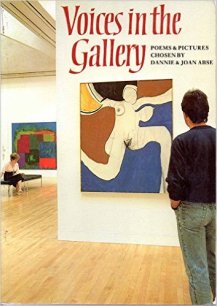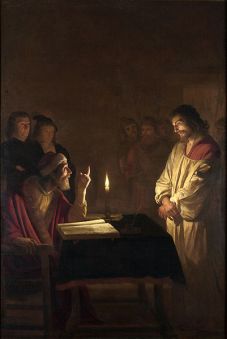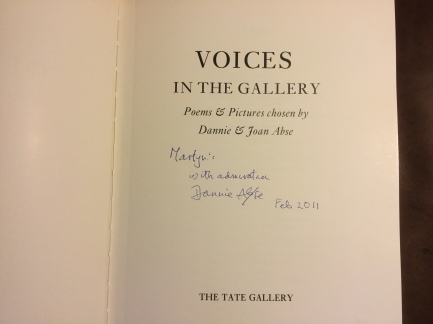
Two things dove-tailing this week . . . My thoughts way ahead of time about ekphrastic poems (poems stimulated by visual art) in relation to the workshop I am scheduled to run at the Holburne Museum in Bath in February 2017. The particular exhibition was in the news this last week as they will be showing, amongst many others, a newly-rediscovered painting by Peter Breughel. Also I went to the Beyond Caravaggio exhibition at The National Gallery a couple of days ago. There, though the numbers of Carravaggios per square metre of wall space is relatively low, much of what’s on display by those who came under his influence is well worth seeing.
At the end of the 16th century Caravaggio brought an almost photographic precision to painting, mixing elements of still life with portraits and religious subjects. His people are caught (again almost photographically) in realistic seeming mid-gesture, twisting, stooping, hands wide or aloft. Then there’s the light: powerful light sources cast illumination and correspondingly deep shadows across the figures, darkening the brows of a face, across a hand at a card game, on exposed flesh. One of the ‘followers’ turns out to be Gerrit van Honthorst whose towering ‘Christ before the High Priest’ is displayed in the final room. As I came across it I had one of those moments of recognition. The picture has been in the National Gallery collection for many years and it provided the (ekphrastic) stimulation for one of my earliest poems.

The poem eventually appeared in my first book, Beneath Tremendous Rain (Enitharmon, 1990) and I’ve always had a soft spot for it as Dannie Abse chose to include it in the plush, coffee-table anthology called Voices in the Gallery (Tate Gallery Publications) he edited 1986 with Joan, his wife and art historian. For a wannabe poet with no book yet it was a dizzying moment – a not-to-be repeated moment – being sandwiched between Zbigniew Herbert, W. H. Auden and Thomas Hardy! Year later I got Dannie to sign my original copy of it.

The voice in my poem is naïve and unknowing, an art historian ignoramus (close to the autobiographical truth). But he looks hard, starting with a bewildered rationalism as he tries to get to grips with the stylised, stiff religious images of the “early galleries”. He understands he’s nothing more than one of the “casual visitors” who prefer to gaze at something familiar, the “recognisable gesture”, the more simply realistic and identifiable images contained in later works. But gradually he recognises the thorough-going empiricism of “dimension, distance and the need for accuracy” has its own limits (I still like the dig against my own gender’s devotion of facts, though the portrayal of the too submissive female partner I’d not let through these days).
The Expressionistic distortions of Van Gogh (“inconsistent with the camera”) begin to appeal to him as he understands the impossibility of a truly objective view (“eyes jaundiced / only with being human and limited”) which – he seems to be on a circular walk round the National Gallery – then allows him to re-assess the earlier images. With the passage of time and the loss of religious faith (I was sure of it then, back in the 1980s), these pictures also openly admit their distortions. Their “dogma is laughable now, or / almost so”. They obviously possess no camera-like claim to objectivity or all-inclusiveness. Rather they now seem to him to admit “in all self-consciousness, / other possibilities multiplying beyond the frame”. It’s at that point the image of Honthorst’s ‘Christ before the High Priest’ comes to mind. It seemed to me then an image that was interesting and powerful at least as much for what lies just out of sight as for what the casual visitor can see plainly.
Years later, in different poetic modes, I’m still intrigued by what lies just beyond our reach – the Daoist’s uncarved block of wood – still think it has as much power as what we plainly see. Here’s the old poem in full:
At The National Gallery
What am I to do with these angels’ wings,
with the literalness of these gaping heavens
and haloes in the early galleries?
No-one believes them. Beyond meaning,
they are absurd – mannered and posed figures
as unlikely as the nude’s fig-leaf, the wooden
gestures of saints staring straight through you:
uncomfortable attitudes, seeming content
with their fantasies of transfiguration and myth.
Yet casual visitors walk right past. They’re drawn
to quotidian scenes, the scruffy breeches, old hats
in later pictures where they scribble notes,
trying to capture the vanishing feelings
of viewing these captured moments
of vanishing things – the recognisable gesture
at an execution, on the river, in the boudoir.
And I with them, yet always end uncomfortably
tracing holiday strolls through Canaletto’s
Venice or impatient somehow with men
who explain to their quiet partners about
dimension, distance and the need for accuracy.
But Van Gogh’s crippled chair confounds them,
restores a sense of things perceived in ways
inconsistent with the camera, eyes jaundiced
only with being human and limited which is
other than the capture of fleeting things,
the stunned insect, and like verse that must
struggle to avoid its final stop: another fairy-tale
though there are no haloes, no heaven here.
And I go back to those old pictures to find
their appeal, uncovered, is the honesty, almost
innocence, time has forced upon them,
for what was then dogma is laughable now, or
almost so. Uncameralike, their contentment admits,
rather asserts in all self-consciousness,
other possibilities multiplying beyond the frame:
like the one candle, illuminating a room,
the gleaming tabletop, across which one detailed,
serious face confronts another, unnaturally
bound in by a darkness in which we make out
nothing, yet know someone moves inches beyond
vision, rising, strained forward and demanding:
Give me some light, I say, lights! Now! A taper!

Thanks for this. Interesting…
My Advanced Poetry class (tutor Sarah Wardle) at Morley College have ,on my organising, been three times to the Dulwich Picture Gallery on ekphrastic outings; and produced poems.
The first was for the Norwegian painter Nikolai Astrup, the second for the forgotten woman Winifred Knights, and the last , a week ago, for the Dutchman Adriaan Van Der Velde… And maybe before Astrup for M C Escher and Eric Ravilious.
So ,Martyn, ‘been there ,done that’.
I live until the end of the month in Dulwich and have done since September 2013.
Best wishes,
Michael >
LikeLike
I have grown more uneasy about ekphrastic poems over the years though they provide a good starting point often. I feel they always have to out-grow the origin significantly to survive. Not sure I feel the same way about poems starting from photographs though I suppose because the art object is already an interpretation.
LikeLike
Interesting. I love ekphrastic poetry, and I also write a lot of it. I don’t really know what draws me to it, though. But I’ve always felt that ekphrastic poetry has to work that little bit harder, to convince the reader that it is worth something in itself, not just as an offshoot from great artworks… I particularly enjoyed a collection by Kelly Grovier: http://createdtoread.com/ekphrastic-poetry-from-kelly-grovier/ and will be posting something this week, about poetry in response to the Pre-Raphaelites.
LikeLike
Great read, as always. Thanks for the link to the Breughel article – that exhibition sounds like a must-see. Really enjoyed your poem – it certainly invoked the experience of walking round a permanent collection here in the UK. I think you’re being too hard on yourself re: ‘the quiet partners’ – and it’s not just that he might be guilty of ‘mansplaining’, it’s because their quietness could just as easily show their devotion to the difficult task of appreciating the pictures in front of them – as their submission.
N.B. The Auden influence is strong in that line beginning “At an execution…”
LikeLike
Thanks Colin – mansplaining is good. Interesting we have a word for it nowadays. I regard that as a sign of progress. I really did imagine the poor ‘partner’ fuming quietly as he banged on regardless and she’s planning how to escape the relationship! But I thankfully avoided getting into all that in the poem.
LikeLike